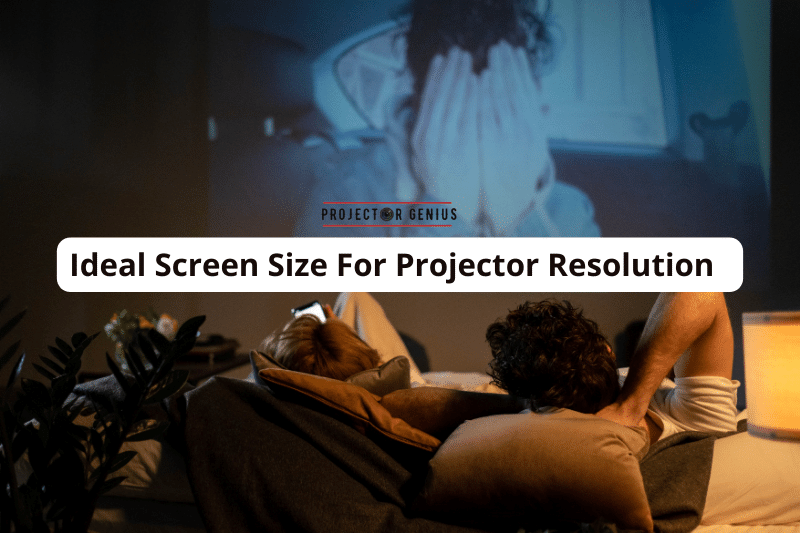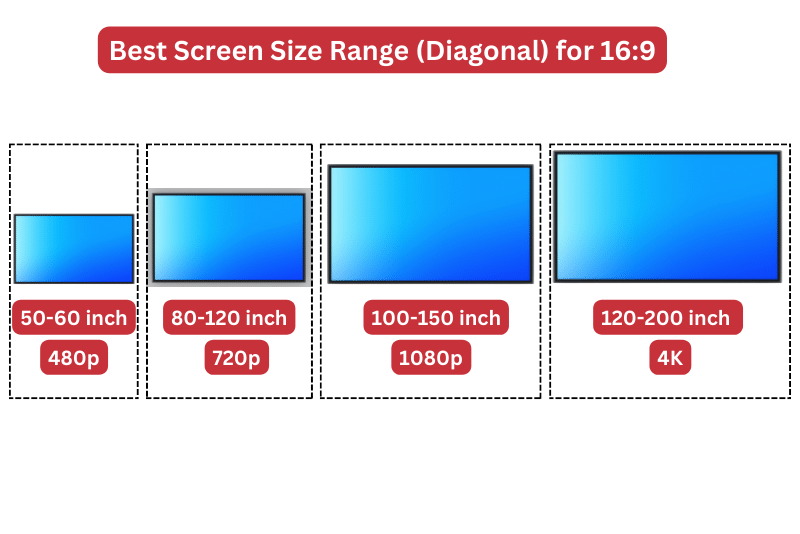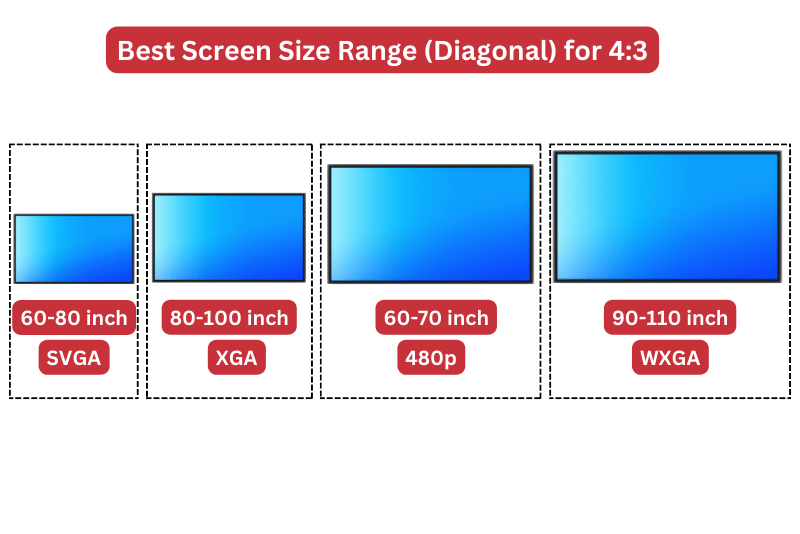Choosing the Ideal Screen Size Based on Projector Resolution [2023 Comprehensive Guide]
-
 Written by:
Kristy Roger
Written by:
Kristy Roger
- Last Updated:
Are you puzzled about which screen size works best with your projector’s resolution?
Trust me, you’re not alone. I’ve been there, and that’s why I created this guide.
Picking the right screen size isn’t just about going big; it’s about clarity, quality, and saving some cash.
Why does this matter? A perfect match between screen and projector makes movies look sharp, games feel immersive, and presentations truly shine.
You don’t want to waste time or money on a setup that falls short. So, stick around as we explore how to find that ideal screen size based on projector resolution.
Your future movie nights will thank you!

I recommend using the Table of Contents to quickly access the information you need.
My article is designed to cater to home cinema users of all levels, from Beginners to Advanced enthusiasts.
Table of Contents
Screen Size Recommendations for Common Projector Resolutions
The ideal screen size for a given projector resolution depends on various factors, including viewing distance, content type, and personal preference.
Before discussing factors in detail consider these general recommendations based on common projector resolutions to ensure optimal image clarity and viewer comfort.


480p (640×480 or 854×480)
Screen Size: 50-70 inches
Typical Use: Older video formats, retro gaming, basic presentations where high resolution is not critical.
720p (HD) (1280×720)
Screen Size: 80-120 inches
Typical Use: Budget home theaters, casual gaming, educational presentations.
SVGA (800×600)
Screen Size: 60-80 inches
Typical Use: Basic presentations, classrooms with older equipment.
XGA (1024×768)
Screen Size: 80-100 inches
Typical Use: Standard presentations, classrooms, and conference rooms.
WXGA (1280×800)
Screen Size: 90-110 inches
Typical Use: Widescreen presentations, classrooms, and conference rooms.
Full HD (1920×1080)
Screen Size: 100-150 inches (or even larger for home theaters)
Typical Use: Home theaters, high-end conference rooms, gaming setups.
WUXGA (1920×1200)
Screen Size: 110-160 inches
Typical Use: High-definition presentations, professional setups.
4K (3840×2160)
Screen Size: 120-200 inches or more
Typical Use: Premium home theaters, professional cinema setups, high-end gaming.
8K (7680×4320)
Screen Size: 150 inches and above
Typical Use: Ultra-premium home theaters, professional cinema setups, specialized commercial applications.
Note: These are general recommendations. The ideal screen size can vary based on the specific use-case, room size, ambient light, and viewer preferences.
For instance, in a home theater setup, viewers might prefer a more immersive experience and opt for a larger screen even with lower resolutions.
Conversely, in a bright conference room, a smaller, brighter image might be more effective.
When choosing a screen size, it’s also essential to consider the projector’s throw ratio to ensure it can project an image of the desired size from the available distance.
What is Relationship Between Projector Resolution and Screen Size?
The relationship between projector resolution and screen size is an important consideration when setting up a home theater, conference room, or any other projection system. Here’s how they are related:
Resolution
Resolution refers to the number of pixels that a projector can display, commonly expressed as width x height (e.g., 1920×1080 for Full HD). Higher resolution means more pixels, which generally means a sharper and clearer picture.
Screen Size
Screen size is the diagonal measurement of the screen on which the image is projected. It’s usually measured in inches or centimeters.
Relationship
Pixel Density: Higher resolutions can look good on larger screens because they offer higher pixel density, meaning the pixels are packed more tightly together. This results in a clearer, sharper image. On the other hand, projecting a low-resolution image on a large screen can result in a “pixelated” or blurry image.
Viewing Distance: The ideal screen size also depends on how far the audience is from the screen. Higher resolutions can be more forgiving in terms of viewing distance; that is, you can sit closer to a high-resolution screen without noticing pixelation compared to a lower-resolution screen.
Aspect Ratio: Both projectors and screens have an aspect ratio (e.g., 16:9, 4:3). It’s important to match the aspect ratio of the projector and the screen to avoid image distortion.
Brightness: Larger screens may require projectors with higher brightness (measured in lumens) to maintain image quality, especially in well-lit rooms.
Content: The resolution of the content you’re displaying also matters. Displaying low-resolution content on a high-resolution projector and large screen won’t improve its quality.
Budget and Space: Higher resolution projectors and larger screens generally cost more. Additionally, you’ll need to consider whether you have enough space to accommodate the screen size and whether the projector has the capability to throw an image that size from the available distance (known as “throw distance”).
Scalability: Some projectors have better internal scaling engines than others. If you’re projecting content that doesn’t match the projector’s native resolution, a good scaling engine can make a difference in image quality.
Text and Detail: If you’re using the projector for presentations that include a lot of text or fine details, a higher resolution will generally be beneficial, regardless of screen size.
Immersive Experience: For home theaters, a larger screen with a higher resolution can provide a more immersive viewing experience.
In summary, while higher resolutions generally look better on larger screens, the relationship between projector resolution and screen size is influenced by a variety of factors including the content, viewing distance, and the specific use-case scenario.
What Other Factors Influencing Screen Size Selection?
Selecting the appropriate screen size for a projector setup involves considering a variety of factors. Here are some key considerations:
Room Size and Layout
Room Dimensions: The size of the room will directly impact how large a screen you can accommodate. A larger room can generally support a larger screen.
Ceiling Height: A low ceiling may limit how large a screen can be installed or how high it can be positioned.
Wall Space: The available wall space will also dictate the maximum screen size you can use.
Furniture Placement: The arrangement of seating and other furniture can affect the optimal screen size and viewing angles.
Viewing Distance
Optimal Distance: The distance between the screen and the audience should be appropriate for the screen size to ensure a comfortable and clear viewing experience.
THX and SMPTE Guidelines: Organizations like THX and SMPTE provide guidelines for optimal viewing distances based on screen size and resolution.
Projector Capabilities
Resolution: Higher resolution projectors generally allow for larger screens without loss of image quality.
Brightness: A larger screen may require a brighter projector to maintain image quality, especially in well-lit rooms.
Throw Ratio: This is the ratio of the distance from the lens to the screen to the screen width. Make sure your projector can throw an image large enough to fill your screen from the available distance.
Content-Type
Resolution of Content: High-definition or 4K content will generally look better on larger screens.
Aspect Ratio: The aspect ratio of the content you’ll be displaying (16:9, 4:3, etc.) should match the aspect ratio of your screen to avoid letterboxing or stretching.
Purpose: Whether it’s for movies, presentations, or gaming can influence the ideal screen size. For example, presentations may require smaller text that needs to be legible from a distance, influencing screen size and projector resolution.
Ambient Light
Room Brightness: Rooms with a lot of ambient light may require a smaller, brighter image to maintain visibility and image quality.
Screen Material: Some screen materials are better at rejecting ambient light, which can influence how large a screen you can effectively use.
Budget
Cost: Larger, high-quality screens and the projectors capable of filling them with a bright, high-resolution image can be expensive.
Aesthetics and Practicality
Room Aesthetics: The screen should fit well with the room’s decor and not dominate the space unless that is the intent.
Installation: Consider the complexity and cost of installing the screen, especially if it’s a fixed, tensioned, or motorized model.
Portability: If the setup needs to be mobile, a smaller, portable screen might be more suitable.
By carefully considering these factors, you can select a screen size that provides a high-quality viewing experience tailored to your specific needs.
How to Test and Adjust Screen Size?
Testing and adjusting screen size for a projector setup involves a series of steps to ensure optimal image quality and viewer comfort. Here’s a guide on how to go about it:
Preliminary Steps
Read the Manual: Check the projector’s manual for specifications related to throw distance, aspect ratio, and resolution. This will give you an idea of the screen sizes that the projector can handle effectively.
Measure the Room: Measure the dimensions of the room, including the distance between the projector and the screen, as well as the distance from the screen to the viewing area.
Calculate Throw Ratio: Use the projector’s throw ratio to calculate the appropriate screen size. The throw ratio is the distance from the lens to the screen divided by the screen width.
Testing Screen Size
Temporary Screen: Before installing a permanent screen, you can project onto a white wall or use a portable screen to test different sizes.
Test Patterns: Use test patterns or grid lines to help align the image. Many projectors have built-in test patterns for this purpose.
Adjust Zoom and Focus: Use the projector’s zoom and focus controls to fine-tune the image size and clarity.
Check Aspect Ratio: Make sure the aspect ratio of the projected image matches that of your screen to avoid distortion.
Viewing Distance: Test the setup from various viewing distances to ensure that the image remains clear and comfortable to view from different parts of the room.
Content Testing: Play different types of content that you plan to use regularly. This will give you an idea of how well the setup works for your specific needs.
Ambient Light: Test the setup under various lighting conditions to see how well the image holds up in both dark and bright settings.
Audience Feedback: If possible, get feedback from potential viewers to ensure the screen size is comfortable for everyone.
Adjusting Screen Size
Reposition Projector: If the image is too large or too small, you may need to move the projector closer to or farther away from the screen.
Lens Shift and Keystone Correction: Use these features cautiously to adjust the image size and alignment, but note that excessive use can distort the image and reduce quality.
Screen Adjustment: Some screens have adjustable frames that allow you to change the screen size slightly. This can be useful for fine-tuning the setup.
Projector Settings: Go through the projector’s menu to see if there are settings that allow you to adjust the image size, aspect ratio, or other relevant parameters.
Final Calibration: Once you’ve settled on a screen size, you may want to perform a final calibration to optimize color, contrast, and brightness.
By carefully testing and adjusting the screen size, you can ensure that you get the best possible image quality and viewing experience from your projector setup.
Frequently Asked Questions (FAQs)
Can I use a larger screen for higher resolution projectors?
When it comes to using a larger screen with higher resolution projectors, there’s a key consideration. You see, a larger screen can indeed enhance the visual experience. It allows for a more immersive display of your content. However, there’s a catch. It’s important to ensure that the projector can handle the increased screen size.
You might wonder why. Well, here’s the scoop: if the projector’s native resolution isn’t up to par with the screen’s size, you might end up with a pixelated or blurry image. That’s definitely not the outcome you’re hoping for, right? So, always check the specs of both the projector and the screen.
Another thing to keep in mind is the aspect ratio. It’s a critical factor. You want to make sure that the screen’s aspect ratio matches the projector’s native aspect ratio. This way, you’ll get the best possible image quality without any distortion.
What is the recommended screen size for a small living room?
In my honest opinion, for a small living room, choosing the right screen size is crucial. It’s about striking the perfect balance. A screen that’s too large might overwhelm the space, while one that’s too small could lead to squinting and a less enjoyable viewing experience.
So, what’s the sweet spot? Generally, I’d recommend going for a screen size that’s between 60 and 80 inches. This size range tends to work well for most small living rooms. However, it’s essential to consider the viewing distance too. If you’re sitting relatively close to the screen, lean towards the smaller end of that range.
Moreover, consider the layout of your living room. Take into account any furniture or obstacles that might affect the viewing angles. It’s all about creating a comfortable and immersive setup.
Lastly, always factor in the resolution of your projector. A higher resolution projector can handle a larger screen without sacrificing image quality. So, in a nutshell, aim for a screen size between 60 and 80 inches for a small living room, but adjust based on your specific circumstances. This way, you’ll enjoy the best possible viewing experience!
Does screen size impact picture quality?
In my experience, screen size does indeed play a significant role in picture quality. Allow me to explain. When you have a larger screen, it can potentially lead to a more immersive viewing experience. However, there’s a crucial factor to consider: the resolution of the content being displayed.
Here’s the deal: if the screen is too big for the resolution of the content, you might end up with a pixelated or blurry image. It’s akin to trying to stretch a small image to fit a much larger space – it won’t look as sharp or clear.
On the flip side, if you have a high-resolution source (like a 4K Blu-ray player) and a screen that’s appropriately sized, you’ll experience a crisp and detailed picture. It’s all about finding that balance.
So, in summary, yes, screen size does impact picture quality. But it’s not the only factor at play. You also need to consider the resolution of your content. Match the screen size with the appropriate content, and you’ll enjoy a top-notch viewing experience!
Can I adjust the screen size after installation?
Yes, adjusting the screen size after installation is indeed possible. It’s a handy feature that many projectors offer. Typically, you can do this by moving the projector closer to or farther from the screen.
There’s usually a zoom function that allows you to fine-tune the size, too. It’s important to note that while adjusting the screen size is possible, it might require some trial and error to get it just right. You’ll want to ensure that the image remains clear and focused as you make adjustments.
Additionally, remember to check the projector’s or projector screen manual for specific instructions on how to adjust the screen size. Different models may have slightly different methods.
So, in a nutshell, yes, you can adjust the screen size after installation. It’s a useful feature to have, but be prepared to spend a bit of time fine-tuning to get the best result. Always refer to the projector’s manual for guidance on how to do it properly.
Can I use a projector in a small space with a large screen?
In my experience, using a projector in a small space with a large screen is possible, but there are important considerations. It’s crucial to ensure that the projector’s specifications align with the intended screen size. This ensures you get a clear and vibrant image.
Keep in mind that the viewing distance plays a role too. If the room is compact, you might need to position the seating closer to the screen for optimal viewing. Also, consider the layout of the room and any potential obstructions that might affect the viewing angles.
Moreover, be aware of the projector’s throw ratio. This indicates how far the projector needs to be from the screen for a specific screen size. It’s a vital factor in determining if your chosen space can accommodate a large screen.
Final Thoughts on Screen Size Based on Projector Resolution
Selecting the right screen size for a projector setup is a nuanced process influenced by various factors. Room dimensions, ceiling height, available wall space, and furniture placement all impact the optimal screen size. Viewing distance, guided by THX and SMPTE recommendations, is crucial for a comfortable viewing experience. Projector capabilities, including resolution, brightness, and throw ratio, must align with the intended screen size.
Additionally, content type, ambient light, budget, and aesthetic considerations play vital roles in the decision-making process. The relationship between projector resolution and screen size emphasizes the importance of pixel density, viewing distance, aspect ratio matching, brightness, and content resolution.
Screen size recommendations for common projector resolutions provide practical guidance. Testing and adjusting screen size involve careful measurement, calculation, and testing with temporary screens or test patterns. Overall, a thoughtful approach to screen size selection ensures an optimal viewing experience tailored to specific needs and preferences.
Author of this Post:

Kristy Roger
Home Cinema Consultant & Tech Enthusiast
Holding a background in Industrial and Electrical Technology from the University of Alberta, Kristy has spent 5+ years consulting on home theater products at a top electronics firm. As a certified Technical Professional with Lean Six Sigma credentials, Kristy expertise ranges from projector nuances to hands-on experience with leading models. Kristy have been sharing her knowledge online for two years, blending professional insights with personal experiences from her own home cinema setup. Off the screen, She is a dedicated mom to Jerry, Ryan, and our two pups, Cuddle and Paw.



